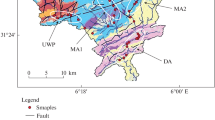Abstract
During the calculation of the oil and gas resources of Western Siberia, especially in the sediments of the Tyumen Formation, the presence of thin nonreservoir clay intercalations must be accounted for. However, the resolution of standard geophysical methods that are used to identify productive sequences is insufficient, and the clay intercalations are included into the total thickness of reservoir rocks, which leads to considerable errors during resource assessment. The most efficient method for the estimation of clay mineral content in sedimentary rocks is the gamma method or gamma-ray well logging, which is typically used for this purpose. However, its application requires the knowledge of correlations between the abundance of clay minerals in the sediments; the contents of K, U, and Th; and total radioactivity. To solve this problem, four grain-size fractions (sand, coarse silt, fine silt, and clay) were separated from the sediments of the Tyumen Formation at the Lovin Field and were analyzed for naturally radioactive elements (NRE), total radioactivity, and mineral composition. The tendencies found in the distribution of NRE and total radioactivity in different grain-size fractions provided a methodical basis for the determination of clay mineral contents in the productive sediments of the Tyumen Formation at the Lovin Field using gamma-spectrometric data.
Similar content being viewed by others
References
R. P. Gottikh, Radioactive Elements in Petroleum Geology (Nedra, Moscow, 1989) [in Russian].
W. H. Fertl, “Spectrometry of Natural γ Radiation in Boreholes,” Neft’ Gaz Neftekhim. Rubezh., Nos. 3–6, 10 (1983).
J. A. S. Adams and C. E. Weaver, “Thorium-to-Uranium Ratios as Indicators of Sedimentary Process: Example of Concept of Geochemical Facies,” Bull. Am. Assoc. Petrol. Geol. 42, 387–430 (1956).
Main Features of Uranium Geochemistry, Ed. by A. P. Vinogradov, (Akad. Nauk SSSR, Moscow, 1963) [in Russian].
A. A. Smyslov, Uranium and Thorium in the Earth’s Crust (Nedra, Leningrad, 1974) [in Russian].
V. F. Pen’kov, Uranium and Hydrocarbons (Nedra, Moscow, 1989) [in Russian].
M. Yu. Zubkov, “Analysis of K, U, Th, and B Distribution in the Upper Jurassic Sediments of the Central Part of the Krasnoleninsk Arch (Western Siberia) with the Aim of Stratification, Correlation, and Separation of Pay Sands,” Geokhimiya, No. 1, 51–70 (2001) [Geochem. Int. 39, 45–63 (2001)].
V. A. Kovalev, “Geochemical Aspects of the Investigation of Th/U Ratio in Sedimentary Rocks,” Geokhimiya, No. 9, 1171–1173 (1965).
M. Yu. Zubkov, Ya. A. Pormeister, and V. I. Nikolyuk, “Prediction of Hydrocarbon Reservoirs on the Basis of Tectonophysical Modeling as Exemplified by the Slavin Field,” in Approaches to the Realization of the Petroleum Potential of KhMAO (Khanty-Mansiisk, 2004), Vol. 1, pp. 114–131.
E. K. Markhinin, Volcanoes and Life (Mysl’, Moscow, 1980) [in Russian].
Author information
Authors and Affiliations
Corresponding author
Additional information
Original Russian Text © M.Yu. Zubkov, 2008, published in Geokhimiya, 2008, No. 5, pp. 505–523.
Rights and permissions
About this article
Cite this article
Zubkov, M.Y. Assessment of clay content from the analysis of K, U, and Th distribution in different grain-size fractions of the productive sediments of the Lovin Field, Western Siberia. Geochem. Int. 46, 465–481 (2008). https://doi.org/10.1134/S0016702908050030
Received:
Published:
Issue Date:
DOI: https://doi.org/10.1134/S0016702908050030




